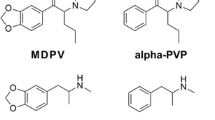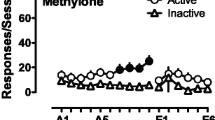Abstract
Rationale
The use of synthetic cathinones as recreational drugs frequently sold in combination has been increasing exponentially. However, the consequences of combining cathinones on the resulting stimulant effects and the pharmacokinetics have been poorly investigated.
Objective and methods
To study 3,4-methylenedioxypyrovalerone (MDPV; 3 mg/kg) and mephedrone (4-MMC; 30 mg/kg)-induced effects on rat locomotor activity and pharmacokinetics, administered alone or in combination by the intragastric route. The pharmacokinetic parameters were determined using non-compartmental analysis and the relationships between the locomotor activity and drug concentrations using sigmoidal Emax modeling.
Results
Locomotor activity significantly increased during the first hour post-administration with the MDPV/4-MMC combination in comparison to MDPV (p < 0.001) and 4-MMC (p < 0.01) alone. The pharmacokinetic profile of MDPV, but not 4-MMC, was significantly modified with the combination resulting in decreases in Cmax (16.4 ± 5.5 versus 62.2 ± 14.2 μg/L, p < 0.05) and AUC0 → ∞ (708 ± 91 versus 3316 ± 682 μg/L/min, p < 0.01) and increases in V/F (582.6 ± 136.8 versus 115.9 ± 42.7 L/kg, p < 0.05) and Cl/F (4.6 ± 0.7 versus 1.2 ± 0.4 L/kg/min, p < 0.01) in comparison to MDPV alone. The sigmoidal Emax model fitted the observed data well; MDPV being markedly more potent than 4-MMC (EC50, 0.043 versus 0.7 μmol/L). The enhancing factor representing the MDPV contribution to the alteration in the relationships between locomotor activity and 4-MMC concentrations was 0.3.
Conclusion
An MDPV/4-MMC combination results in enhanced stimulant effects in the rat, despite significant reduction in MDPV bioavailability. Enhanced effects could be explained by increased MDPV distribution and/or possible complementation at the brain dopaminergic targets. However, the exact consequences of the MDPV/4-MMC combination in humans remain to be clarified.



Similar content being viewed by others
References
Aarde SM, Huang PK, Creehan KM, Dickerson TJ, Taffe MA (2013) The novel recreational drug 3,4-methylenedioxypyrovalerone (MDPV) is a potent psychomotor stimulant: self-administration and locomotor activity in rats. Neuropharmacology 71:130–140. https://doi.org/10.1016/j.neuropharm.2013.04.003
Aarde SM, Creehan KM, Vandewater SA, Dickerson TJ, Taffe MA (2015) In vivo potency and efficacy of the novel cathinone α-pyrrolidinopentiophenone and 3,4 methylenedioxypyrovalerone: self-administration and locomotor stimulation in male rats. Psychopharmacology 232:3045–3055. https://doi.org/10.1016/j.neuropharm.2013.04.003
Alvarez JC, Etting I, Abe E, Villa A, Fabresse N (2017) Identification and quantification of 4 -methylethcathinone (4-MEC) and 3,4-methylenedioxypyrovalerone (MDPV) in hair by LC-MS/MS after chronic administration. Forensic Sci Int 270:39–45 https://www.sciencedirect.com/science/article/pii/S0379073816305047?via%3Dihub
Anizan S, Concheiro M, Lehner KR, Bukhari MO, Suzuki M, Rice KC, Baumann MH, Huestis MA (2016) Linear pharmacokinetics of 3,4-methylenedioxypyrovalerone (MDPV) and its metabolites in the rat: relationship to pharmacodynamic effects. Addict Biol 21:339–347. https://doi.org/10.1111/adb.12201
Baumann MH, Ayestas MA Jr, Partilla JS, Sink JR, Shulgin AT, Daley PF, Brandt SD, Rothman RB, Ruoho AE, Cozzi NV (2012) The designer methcathinone analogs, mephedrone and methylone, are substrates for monoamine transporters in brain tissue. Neuropsychopharmacology 37:1192–1203. https://doi.org/10.1038/npp.2011.304
Baumann MH, Partilla JS, Lehner KR, Thorndike EB, Hoffman AF, Holy M, Rothman RB, Goldberg SR, Lupica CR, Sitte HH, Brandt SD, Tella SR, Cozzi NV, Schindler CW (2013) Powerful cocaine-like actions of 3,4-methylenedioxypyrovalerone (MDPV), a principal constituent of psychoactive ‘bath salts’ products. Neuropsychopharmacology 38:552–562. https://doi.org/10.1038/npp.2012.204
Berquist MD, Traxler HK, Mahler AM, Baker LE (2016) Sensitization to the locomotor stimulant effects of “bath salt” constituents, 4-methylmethcathinone (4-MMC) and 3,4-methylenedioxypyrovalerone (MDPV), in male Sprague-Dawley rats. Drug Alcohol Depend 164:128–134. https://doi.org/10.1016/j.drugalcdep.2016.05.001
Cameron K, Kolanos R, Vekariya R, De Felice L, Glennon RA (2013a) Mephedrone and methylenedioxypyrovalerone (MDPV), major constituents of “bath salts,” produce opposite effects at the human dopamine transporter. Psychopharmacology 227:493–499. https://doi.org/10.1007/s00213-013-2967-2
Cameron KN, Kolanos R, Solis E Jr, Glennon RA, De Felice LJ (2013b) Bath salts components mephedrone and methylenedioxypyrovalerone (MDPV) act synergistically at the human dopamine transporter. Br J Pharmacol 168:1750–1757. https://doi.org/10.1111/bph.12061
Ciudad-Roberts A, Duart-Castells L, Camarasa J, Pubill D, Escubedo E (2015) The combination of ethanol with mephedrone increases the signs of neurotoxicity and impairs neurogenesis and learning in adolescent CD-1 mice. Toxicol Appl Pharmacol 293:10–20. https://doi.org/10.1016/j.taap.2015.12.019
Colon-Perez LM, Tran K, Thompson K, Pace MC, Blum K, Goldberger BA, Gold MS, Bruijnzeel AW, Setlow B, Febo M (2016) The psychoactive designer drug and bath salt constituent MDPV causes widespread disruption of brain functional connectivity. Neuropsychopharmacology 41:2352–2365. https://doi.org/10.1038/npp.2016.40
Den Hollander B, Rozov S, Linden AM, Uusi-Oukari M, Ojanperä I, Korpi ER (2013) Long-term cognitive and neurochemical effects of “bath salt” designer drugs methylone and mephedrone. Pharmacol Biochem Behav 103:501–509. https://doi.org/10.1016/j.pbb.2012.10.006
Dines AM, Wood DM, Yates C, Heyerdahl F, Hovda KE, Giraudon I, Sedefov R, Dargan PI, Euro-DEN Research Group (2015) Acute recreational drug and new psychoactive substance toxicity in Europe: 12 months data collection from the European Drug Emergencies Network (Euro-DEN). Clin Toxicol (Phila) 53:893–900 https://www.tandfonline.com/doi/abs/10.3109/15563650.2015.1088157?journalCode=ictx20
Eshleman AJ, Wolfrum KM, Hatfield MG, Johnson RA, Murphy KV, Janowsky A (2013) Substituted methcathinones differ in transporter and receptor interactions. Biochem Pharmacol 85:1803–1815. https://doi.org/10.1016/j.bcp.2013.04.004
Fantegrossi WE, Gannon BM, Zimmerman SM, Rice KC (2013) In vivo effects of abused ‘bath salt’ constituent 3,4-methylenedioxypyrovalerone (MDPV) in mice: drug discrimination, thermoregulation, and locomotor activity. Neuropsychopharmacology 38:563–573. https://doi.org/10.1016/j.bcp.2013.04.004
Gunderson EW, Kirkpatrick MG, Willing LM, Holstege CP (2013) Substituted cathinone products: a new trend in “bath salts” and other designer stimulant drug use. J Addict Med 7:153–162. https://doi.org/10.1097/ADM.0b013e31829084b7
Harvey EL, Baker LE (2016) Differential effects of 3,4-methylenedioxypyrovalerone (MDPV) and 4-methylmethcathinone (mephedrone) in rats trained to discriminate MDMA or a d-amphetamine + MDMA mixture. Psychopharmacology 233:673–680. https://doi.org/10.1097/ADM.0b013e31829084b7
Huang PK, Aarde SM, Angrish D, Houseknecht KL, Dickerson TJ, Taffe MA (2012) Contrasting effects of d-methamphetamine, 3,4-methylenedioxymethamphetamine, 3,4-methylenedioxypyrovalerone, and 4-methylmethcathinone on wheel activity in rats. Drug Alcohol Depend 126:168–175. https://doi.org/10.1016/j.drugalcdep.2012.05.011
Johnson PS, Johnson MW (2014) Investigation of “bath salts” use patterns within an online sample of users in the United States. J Psychoactive Drugs 46:369–378. https://doi.org/10.1080/02791072.2014.962717
Karila L, Mégarbane B, Cottencin O, Lejoyeux M (2015) Synthetic cathinones: a new public health problem. Curr Neuropharmacol 13:12–20 http://www.eurekaselect.com/126867/article
Karlsson L, Andersson M, Kronstrand R, Kugelberg FC (2014) Mephedrone, methylone and 3,4-methylenedioxypyrovalerone (MDPV) induce conditioned place preference in mice. Basic Clin Pharmacol Toxicol 115:411–416. https://doi.org/10.1111/bcpt.12253
Kehr J, Ichinose F, Yoshitake S, Goiny M, Sievertsson T, Nyberg F, Yoshitake T (2011) Mephedrone, compared with MDMA (ecstasy) and amphetamine, rapidly increases both dopamine and 5-HT levels in nucleus accumbens of awake rats. Br J Pharmacol 164:1949–1958. https://doi.org/10.1111/j.1476-5381.2011.01499.x
Kiyatkin EA, Kim AH, Wakabayashi KT, Baumann MH, Shaham Y (2015) Effects of social interaction and warm ambient temperature on brain hyperthermia induced by the designer drugs methylone and MDPV. Neuropsychopharmacology 40:436–445. https://doi.org/10.1038/npp.2014.191
López-Arnau R, Martínez-Clemente J, Pubill D, Escubedo E, Camarasa J (2012) Comparative neuropharmacology of three psychostimulant cathinone derivatives: butylone, mephedrone and methylone. Br J Pharmacol 167:407–420. https://doi.org/10.1111/j.1476-5381.2012.01998.x
Martínez-Clemente J, Escubedo E, Pubill D, Camarasa J (2012) Interaction of mephedrone with dopamine and serotonin targets in rats. Eur Neuropsychopharmacol 22:231–236. https://doi.org/10.1016/j.euroneuro.2011.07.009
Martínez-Clemente J, López-Arnau R, Carbó M, Pubill D, Camarasa J, Escubedo E (2013) Mephedrone pharmacokinetics after intravenous and oral administration in rats: relation to pharmacodynamics. Psychopharmacology 229:295–306. https://doi.org/10.1007/s00213-013-3108-7
Marusich JA, Grant KR, Blough BE, Wiley JL (2012) Effects of synthetic cathinones contained in “bath salts” on motor behavior and a functional observational battery in mice. Neurotoxicology 33:1305–1313. https://doi.org/10.1016/j.neuro.2012.08.003
Mayer FP, Wimmer L, Dillon-Carter O, Partilla JS, Burchardt NV, Mihovilovic MD, Baumann MH, Sitte HH (2016) Phase I metabolites of mephedrone display biological activity as substrates at monoamine transporters. Br J Pharmacol 173:2657–2668. https://doi.org/10.1111/bph.13547
Motbey CP, Karanges E, Li KM, Wilkinson S, Winstock AR, Ramsay J, Hicks C, Kendig MD, Wyatt N, Callaghan PD, McGregor IS (2012) Mephedrone in adolescent rats: residual memory impairment and acute but not lasting 5-HT depletion. PLoS One 7:e45473. https://doi.org/10.1371/journal.pone.0045473
Nguyen JD, Aarde SM, Cole M, Vandewater SA, Grant Y, Taffe MA (2016) Locomotor stimulant and rewarding effects of inhaling methamphetamine, MDPV, and mephedrone via electronic cigarette-type technology. Neuropsychopharmacology 41:2759–2771. https://doi.org/10.1038/npp.2016.88
Novellas J, López-Arnau R, Carbó ML, Pubill D, Camarasa J, Escubedo E (2015) Concentrations of MDPV in rat striatum correlate with the psychostimulant effect. J Psychopharmacol 29:1209–1218. https://doi.org/10.1177/0269881115598415
Pail PB, Costa KM, Leite CE, Campos MM (2015) Comparative pharmacological evaluation of the cathinone derivatives, mephedrone and methedrone, in mice. Neurotoxicology 50:71–80 https://www.sciencedirect.com/science/article/pii/S0161813X15001199?via%3Dihub
Philogene-Khalid HL, Hicks C, Reitz AB, Liu-Chen LY, Rawls SM (2017) Synthetic cathinones and stereochemistry: S enantiomer of mephedrone reduces anxiety- and depressant-like effects in cocaine- or MDPV-abstinent rats. Drug Alcohol Depend 178:119–125 https://www.sciencedirect.com/science/article/pii/S0376871617302661?via%3Dihub
Rickli A, Hoener MC, Liechti ME (2015) Monoamine transporter and receptor interaction profiles of novel psychoactive substances: para-halogenated amphetamines and pyrovalerone cathinones. Eur Neuropsychopharmacol 25:365–376. https://doi.org/10.1016/j.neuro.2015.08.004
Ross EA, Reisfield GM, Watson MC, Chronister CW, Goldberger BA (2012) Psychoactive “bath salts” intoxication with methylenedioxypyrovalerone. Am J Med 125:854–858. https://doi.org/10.1016/j.amjmed.2012.02.019
Šíchová K, Pinterová N, Židková M, Horsley RR, Lhotková E, Štefková K, Vejmola Č, Uttl L, Balíková M, Kuchař M, Páleníček T (2018) Mephedrone (4-methylmethcathinone): acute behavioral effects, hyperthermic, and pharmacokinetic profile in rats. Front Psychiatry 8:306 https://www.frontiersin.org/articles/10.3389/fpsyt.2017.00306/full
Simmler LD, Buser TA, Donzelli M, Schramm Y, Dieu LH, Huwyler J, Chaboz S, Hoener MC, Liechti ME (2013) Pharmacological characterization of designer cathinones in vitro. Br J Pharmaco 168:458–470. https://doi.org/10.1111/j.1476-5381.2012.02145.x
Spiller HA, Ryan ML, Weston RG, Jansen J (2011) Clinical experience with and analytical confirmation of “bath salts” and “legal highs” (synthetic cathinones) in the United States. Clin Toxicol (Phila) 49:499–505 https://www.tandfonline.com/doi/abs/10.3109/15563650.2011.590812?journalCode=ictx20
Wakabayashi KT, Ren SE, Kiyatkin EA (2015) Methylenedioxypyrovalerone (MDPV) mimics cocaine in its physiological and behavioral effects but induces distinct changes in NAc glucose. Front Neurosci 9:324. https://doi.org/10.3389/fnins.2015.00324
Winstock A, Mitcheson L, Ramsey J, Davies S, Puchnarewicz M, Marsden J (2011) Mephedrone: use, subjective effects and health risks. Addiction 106:1991–1996. https://doi.org/10.1111/j.1360-0443.2011.03502.x
Wood DM, Greene SL, Dargan PI (2011) Clinical pattern of toxicity associated with the novel synthetic cathinone mephedrone. Emerg Med J 28:280–282. https://doi.org/10.1136/emj.2010.092288
Wright MJ Jr, Angrish D, Aarde SM, Barlow DJ, Buczynski MW, Creehan KM, Vandewater SA, Parsons LH, Houseknecht KL, Dickerson TJ, Taffe MA (2012) Effect of ambient temperature on the thermoregulatory and locomotor stimulant effects of 4-methylmethcathinone in Wistar and Sprague-Dawley rats. PLoS One 7:e44652. https://doi.org/10.1371/journal.pone.0044652
Acknowledgments
The authors would like to thank the Animal Platform, CRP2—UMS 3612 CNRS—US25 Inserm-IRD—Faculté de Pharmacie de Paris, Université Paris-Descartes, Paris, France, for their technical assistance. They would like also to thank Mrs. Alison Good (Scotland, UK) for her helpful review of the manuscript.
Funding
Support was provided solely from institutional and departmental sources from the Institut national de la santé et de la recherche médicale (INSERM).
Author information
Authors and Affiliations
Corresponding author
Ethics declarations
All procedures performed in studies involving animals were in accordance with the ethical standards of the Institutional Animal Care and Use Committee at Paris-Descartes University and by the French Ministry of Higher Education and Research (N° CEEA34.NB.127.12)
Conflict of interest
The authors declare that they have no conflicts of interest.
Additional information
This article belongs to a Special Issue on Bath Salts.
Rights and permissions
About this article
Cite this article
Benturquia, N., Chevillard, L., Poiré, C. et al. Is the 3,4-methylendioxypyrovalerone/mephedrone combination responsible for enhanced stimulant effects? A rat study with investigation of the effect/concentration relationships. Psychopharmacology 236, 891–901 (2019). https://doi.org/10.1007/s00213-018-4962-0
Received:
Accepted:
Published:
Issue Date:
DOI: https://doi.org/10.1007/s00213-018-4962-0




